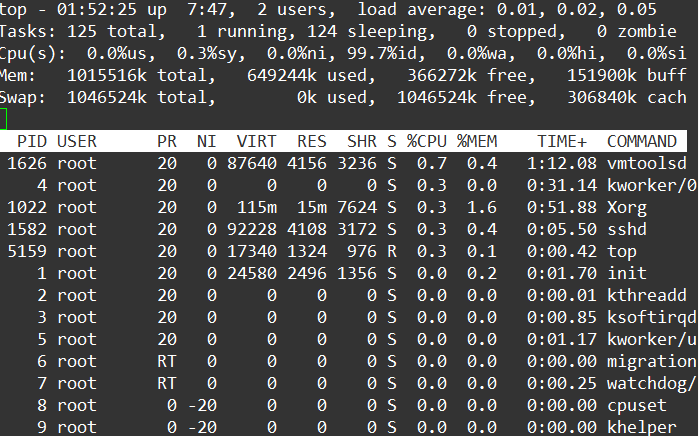进程基本概念
• 进程是linux系统编程中非常重要的概念
• 嵌入式linux 和嵌入式单片机最重要区别
– 嵌入式非常容易实现多任务
• 几个基本概念
– 程序
– 应用
– 进程
• top命令
– x86-Ubuntu以及开发板上执行top命令

进程ID
• 每一个进程都有一个唯一的标识符,进程ID 简称pid
– 进程id 一般默认的最大值为32768,不过也是可以修改的,当然一般情
况下不需要这么做。如果当前进程是1000,那么下一个分配的进程就是
1001,它是严格线性分配的
– 除了init 进程,其它进程都是由其它进程创立的。创立新进程的进程叫父
进程,新进程叫子进程
• man 2 getpid
• man 2 getppid
• 获取子进程的函数
• pid_t getpid(void)
– 参数:无
– 返回值:成功返回进程号
• 获取父进程的函数
• pid_t getppid(void);
– 参数:无
– 返回值:成功返回父进程
• 编写编译运行测试
#include <stdio.h> #include <sys/types.h> #include <unistd.h> void main() { pid_t idp, id; id = getpid(); printf("pid = %d ", id); idp = getppid(); printf("ppid = %d ", idp); }
exec函数族
• linux中,可以使用exec函数族将程序载入内存,实现多个程序的运行

• man 3 exec
• exec函数族参数
– “l”和“v”表示参数是以列表还是以数组的方式提供的
– “p”表示这个函数的第一个参数是*path,就是以绝对路径来提供程序的路径,也可以以当前目录作为目标
– “e”表示为程序提供新的环境变量
• 编写编译运行测试
#include <stdio.h> #include <unistd.h> int main(int argc, char *argv[]) { int ret; char *path = "./helloexec"; ret = execl(path, "helloexec", NULL); if(ret < 0) { printf("execl failed. "); exit(1); } printf("execl success. "); return 0; }
helloexec
#include <stdio.h> int main() { printf("this is helloexec "); return 0; }
fork创建新进程
• linux中,可以使用fork函数创建和当前进程一模一样的进程,叫子进
程,原来的进程叫父进程
• man 2 fork
• 创建进程函数
• pid_t fork(void);
– 参数:无
– 返回值:执行成功,子进程pid 返回给父进程,0 返回给子进程;出现错误-1,返回给父进程。执行失败的唯一情况是内存不够或者id 号用尽,不过这种情况几乎很少发生。
• fork函数(看了例子之后再回头理解一次下面几句话)
– 系统函数fork 调用成功,会创建一个新的进程,它几乎会调用差不多完
全一样的fork 进程
– 子进程的pid 和父进程不一样,是新分配的
– 子进程的ppid 会设置为父进程的pid,也就是说子进程和父进程各自的“父进程”不一样
– 子进程中的资源统计信息会清零
– 挂起的信号会被清除,也不会被继承
– 所有文件锁也不会被子进程继承
• 编写编译运行测试
– 简要分析变量
#include <stdio.h> #include <unistd.h> int main() { pid_t pid; int i = 100; pid = fork(); if(pid == -1) { printf("fork failed "); return 1; } else if(pid == 0) { i++; printf(" The child i = %d ", i); printf("The child return value is %d ", pid); printf("The child pid is %d ", getpid()); printf("The child ppid is %d ", getppid()); while(1); } else { i++; printf(" The father i = %d ", i); printf("The father return value is %d ", pid); printf("The father pid is %d ", getpid()); printf("The father ppid is %d ", getppid()); while(1); } return 0; }
综合例程
• linux命令的本质
– linux命令的本质是一些小程序
• 综合例程
– 包含fork以及所有的exec函数族
• 编写编译运行测试

#include <stdio.h> #include <unistd.h> #include <stdlib.h> int main(void) { char *arg[] = {"ls", "-a", NULL}; if(fork() == 0) { printf("fork1 is Ok; execl "); if(execl("/bin/ls", "ls", "-a", NULL) == -1) { perror("execl error"); exit(1); } } sleep(1); if(fork() == 0) { printf("fork2 is Ok, execv "); if(execv("/bin/ls", arg) == -1) { perror("execv error"); exit(1); } } sleep(1); if(fork() == 0) { printf("fork3 is Ok, execlp "); if(execlp("ls", "ls", "-a", NULL) == -1) { perror("execlp error"); exit(1); } } sleep(1); if(fork() == 0) { printf("fork4 is Ok, execvp "); if(execvp("ls", arg) == -1) { perror("execvp error"); exit(1); } } sleep(1); if(fork() == 0) { printf("fork5 is Ok, execle "); if(execle("/bin/ls", "ls", "-a", NULL, NULL) == -1) { perror("execle error"); exit(1); } } sleep(1); if(fork() == 0) { printf("fork6 is Ok, execve "); if(execve("/bin/ls", arg, NULL) == -1) { perror("execve error"); exit(1); } } return 0; }
